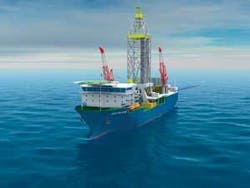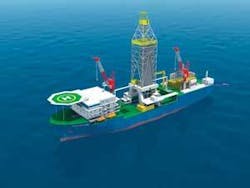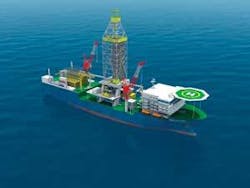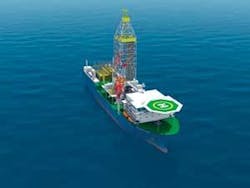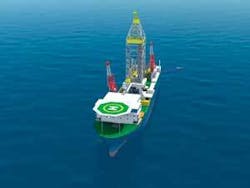Downsized drillship allows operations in wider depth range
Sjoerd Hendriks, Han Tiebout - GustoMSC
In deepwater environments, large and expensive 5th generation drillships are being used for exploration and development wells, completion activities, and intervention and work-over operations. A high percentage of these rigs can also be adapted for early production capability through installation of crude oil storage capacity, additional topsides, and offloading systems.
The crude storage enhancement option can significantly impact the vessel’s design and dimensions. For instance, a below-deck area will need to be set aside for crude storage, forcing drilling equipment to be shifted to the topsides above the main deck. Also, regulations concerning the associated air gap can compromise stability, which in turn affects the vessel’s width.
The consequence of these changes and additional requirements are usually borne by the client in the form of increased day rates. Another negative side-effect is that the resultant process and drilling topsides impede efficient deck logistics, especially in the case of large tubulars, which can obstruct crane operators’ lines of sight.
Within the existing fifth generation drillship fleet, storage facilities are in general not fully used, making many of these vessels more costly to operate than is strictly necessary. To counteract this situation, GustoMSC has adopted a new design philosophy of focusing more closely on the drillship’s intended function, making it as small and compact as possible, without compromising its intended operations. The outcome is the PRD12,000, which combines new drilling technologies that save weight and equipment to reduce the vessel’s size. The resultant ship design also makes drilling and intervention work on subsea wells more efficient and cost effective compared with the traditional MODU.
Design philosophy
The GustoMSC drillship design philosophy has been developed over the years, based on pioneering work with the Pelican-class ships, progressing more recently to the G10,000 and P10,000 class, all matured via close contacts with the drilling industry. Our main goal has always been to design on the actual desired functionality - not over- dimensioning the vessel - while at the same time adapting to any new developments and requirements.
For example, the company has sought to enhance operability by incorporating fully retrievable thrusters in the layout of the ship. The thrusters can be retracted above keel level to improve resistance characteristics for long-distance rig moves, but also retrieved to above the waterline and even up to the main deck. These measures allow maintenance and service without the need for dry-docking of the vessel, saving considerable downtime. A sheltered escape route on both the port and starboard side below the main deck provides a double escape route from aft to fore.
The more compact PRD12,000 design combines pressurized riser drilling with surface BOP technology, allowing both ultra deepwater drilling (in depths to 12,000 ft) and conventional subsea controlled drilling in depths to 5,000 ft. The smaller vessel design has another beneficial effect in that the total investment costs are reduced, due to decreased power generation and thruster size requirements for sailing and maintaining position.
The reduced beam has a positive impact on the vessel’s roll motion characteristics, depending on loading conditions. This should lead to increased uptime, especially during BOP landing operations.
Work on the PRD12,000 concept started in 2003, based on requirements at that time for the upcoming technology of pressurized riser drilling. The rig’s size decrease is achieved through replacing typical heavy subsea drilling equipment, such as the BOP stack, lower marine riser package (LMRP) and marine drilling riser (MDR), with lighter surface equipment, such as a smaller surface BOP stack and a slim line, pressurized riser.
Resultant weight benefits amount to close to 2,000 tons, and the required riser tension decreases by 40%. Mud volume requirements for the slim line riser are lower, reducing the required mud pit and mud pump capacities, and proportionally the power needed during drilling.
A key design feature is the relatively high drill floor for the surface blow-out preventer (SBOP) operations, providing up to 80 ft (24.4 m) of clear height from the waterline. This height is necessary for the mechanical handling of the SBOP and double barrel slip joint. The handling system can also accommodate conventional marine drilling equipment to ensure flexibility regarding drilling modes, and can be operated conveniently from the main deck. This eliminates the need for cellar decks, which consume a lot of hull space below the main deck.
To reduce the vertical center of gravity, the drill floor equipment is divided onto a drill floor and utility floor. Equipment such as draw works, manifolds, and electrical equipment are located on the utility floor at a reduced height.
The PRD12,000 has been sized initially for surface BOP drilling. But subsea drilling can also be incorporated, since the required tank capacities for drill water, mud, base oil, and brine, as well as the storage capacities for cement, barite, bentonite, and the sack store for conventional drilling in 5,000 ft (1,525 m) and for SBOP drilling in 10,000 ft (3,650 m), are all in the same region.
Another important feature is the vessel’s drilling arrangement, with a moonpool of 11.2 m by 9.8 m situated just aft of the midship to provide optimal motion characteristics. Active and passive mud tanks, mud treatment, air compressors, air bottles, offices, and bulk storage silos are located around the moonpool underneath the main deck.
The stern section accommodates the engine rooms under the main deck and the switchboards rooms in the poop deck. Riser storage racks are provided on top of the deck. Drill pipe and casing storage will be made available in cargo holds forward of the moonpool.
On the main deck, between the cargo holds and drilling arrangement, space has been reserved for BOP and Christmas tree storage and handling equipment. Two offshore pedestal cranes will be installed for handling of all equipment on board.
The design tank and load capacities are specifically adapted to the application of surface BOP operations in 10,000-12,000 ft water depth, but these demands also match the requirements for conventional drilling in up to 5,000 ft of water. The ship’s main characteristics are presented in the table above. These ensure autonomous operations for 90 days, or an average of two wells. The accommodation block provides capacity for a crew of 140, and a helideck, suitable for a Sikorsky S61N helicopter, is located on top of the bridge deck.
The targeted operational areas are West Africa, Gulf of Mexico, Asia, and as a base-case scenario, offshore Brazil. The vessel’s dynamic positioning system (DPS-III compliant) allows it to remain connected in up to a 10-year storm condition in Brazilian operational areas. Motion characteristics in DP mode facilitate retrieval and landing of Christmas trees and completions during through-tubing drilling.
All azimuthing thrusters will be retrievable using the standard containerized Gusto Thruster Retrieval System (TRS), which allows inspection and maintenance without time consuming drydocking or vessel relocation. The TRS allows thrusters to be retractable as well. To obtain a high transit speed (up to 14 knots), thrusters 3, 4, and 5 are retractable, while the aft thrusters provide the propulsion power.


